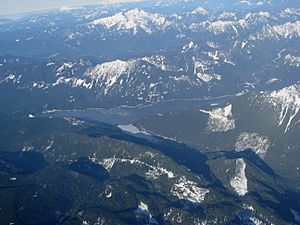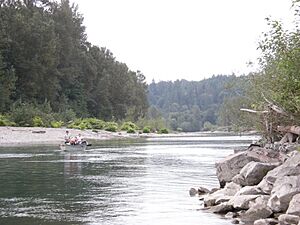Culmback Dam facts for kids
The Culmback Dam is a large dam in Washington. It's also known as the George Culmback Dam. This dam helps provide clean electricity and fresh water to many homes and businesses in Snohomish County. Built in 1965, the dam is 640 ft (200 m) long and 262 ft (80 m) high.
The dam creates a big lake called Spada Lake. This lake provides water for about 70 to 75 percent of Snohomish County. The water from Spada Lake also powers the Jackson Hydro Project, which makes 112 megawatts of clean energy.
Some people worry that the dam might affect fish like salmon in the Sultan River. However, the dam's operators say it helps prevent big floods, which can be good for fish and local communities. The dam was named after George Culmback, a former mayor of Everett.
The Culmback Dam is owned by the Snohomish County PUD (Public Utility District) and the City of Everett. The PUD operates the dam. Water from Spada Lake travels through a long pipeline to a power plant further down the Sultan River. After making electricity, some water goes back into the river, and some is sent to another lake called Lake Chaplain, which is part of Everett's water system.
Quick facts for kids Culmback Dam |
|
|---|---|

The reservoir, Spada Lake, seen from the air, with the dam on the left end of the lake
|
|
| Location | Snohomish County, Washington |
| Coordinates | 47°58′31″N 121°41′11″W / 47.9753°N 121.6865°W |
| Construction began | 1960 |
| Opening date | 1965 |
| Operator(s) | Snohomish County PUD City of Everett |
| Dam and spillways | |
| Impounds | Sultan River |
| Height | 262 ft (80 m) |
| Length | 640 ft (200 m) |
| Elevation at crest | 1,450 ft (440 m) |
| Reservoir | |
| Creates | Spada Lake |
| Total capacity | 165,774 acre⋅ft (204,479,000 m3) |
| Catchment area | 84 sq mi (220 km2) |
| Surface area | 1,870 acres (760 ha) |
| Power station | |
| Commission date | 1983 |
| Hydraulic head | 1,165 ft (355 m) |
| Turbines | 2x 47.5 MW Pelton 2x 8.4 MW Francis |
| Installed capacity | 112 MW |
| Annual generation | 418 million KWh |
Contents
Building the Dam
Before 1917, the City of Everett got its water from a different creek. But as the city grew and needed more water for paper mills and factories, they looked for a bigger water source. They found the Sultan River basin.
The Culmback Dam was built in two main stages.
Phase 1: Starting the Dam
The first stage began in 1960 and finished in 1965. During this time, the dam was built to a height of 200 ft (61 m). This created a reservoir that could hold 40,000-acre-foot (49,000,000 m3) of water. This first part of the dam replaced a smaller dam that was further downstream.
Phase 2: Making it Bigger
The second stage was completed in 1984. The dam was made 62 ft (19 m) taller, reaching its current height. This made the reservoir four times larger! This phase also included building the pipeline that connects Spada Lake to the new power plant and then to Lake Chaplain.
In 2016, the PUD started taking apart a part of the dam called the sluiceway. This was done to help fish, like salmon, swim further up the Sultan River to lay their eggs.
Where the Dam is Located

The Culmback Dam and Spada Lake get their water from an area of 84 sq mi (220 km2). This area is on the western side of the Cascade Range mountains. The valley where the lake is now was formed a very long time ago. The canyon where the dam sits was created about 1 million years ago. This happened when a huge ice sheet, about 1-mile (1.6 km) thick, changed the path of the Sultan River. The river then carved out a narrow gorge, which was a perfect spot to build a dam.
The Sultan River flows into Spada Lake from the east. Other important streams, like the South Fork and Williamson Creek, also feed into the lake.
Water and Power from the Dam
Spada Lake is a very important part of the water supply for the City of Everett and about 80 percent of Snohomish County. There's another smaller lake, Lake Chaplain, that also helps with water supply.
Most of the water from the Sultan River is sent from the dam through a long, 8-mile (13 km) pipe called a penstock. This pipe carries the water to the 112 megawatt (MW) Jackson power plant, which is much lower in elevation. The water drops 1,165 ft (355 m) as it travels, gaining a lot of power.
At the power plant, the water spins four large machines called turbines. Two of these are 47.5 MW Pelton-type turbines, and two are 8.4 MW Francis turbines. These turbines turn generators to make electricity.
After making electricity, the water from the Pelton turbines goes directly back into the Sultan River. The rest of the water is sent through pipes to Lake Chaplain. From Lake Chaplain, the water flows in four large pipes, each 4-foot (1.2 m) wide, towards Everett for people to use.
When there are very heavy rains, the dam can release extra water back into the Sultan River through a special drain called an inverted-bell spillway. This spillway can handle a lot of water, even enough for a very big flood that might only happen once every 100 years.
Fun Activities at the Dam
About 5,000 people visit the area around the Culmback Dam and Spada Lake each year. It's a great place for outdoor activities like boating, hiking, fishing, and kayaking. The lake has two places to launch boats, but you can only use boats without gasoline engines to keep the lake clean and quiet.

